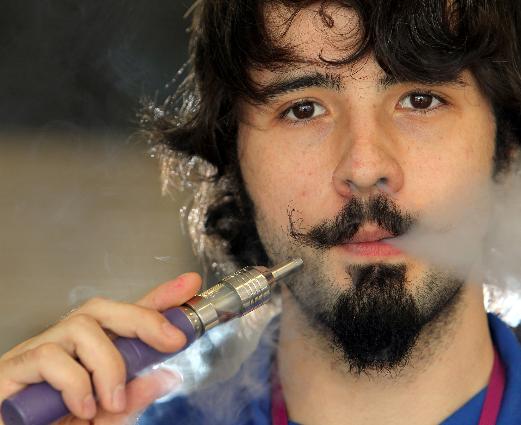Do e-cigarettes help smokers quit?
By Deborah Kotz | THE BOSTON GLOBE STAFF
Electronic cigarettes are certainly trendy — look no further than the Vapefest in the nation’s capital last week — but whether inhaling nicotine vapors actually helps smokers quit traditional cigarettes remains a subject of fierce debate.
A new study is bound to add fuel to the fire. Researchers followed nearly 1,000 smokers for a year and found that those who used e-cigarettes were no more likely to quit smoking or reduce their dependence on tobacco cigarettes than those who weren’t using the products at the beginning of the study. About 14 percent of those who didn’t use e-cigarettes quit smoking compared to 10 percent of those used the products.
But the research, published last Monday in the journal JAMA Internal Medicine, raises more questions than it answers because only 88 of the 949 smokers in the study reported using e-cigarettes.
That small sample size makes it difficult to draw firm conclusions, admits study leader Dr. Pamela Ling, an associate professor of medicine at University of California, San Francisco. “We also looked at a broad population of smokers,” she said, “not just those who were specifically interested in quitting.”
In fact, only 8 percent of e-cigarette users reported that they were trying to quit when they were surveyed, and only 40 percent had any intention of quitting in the next six months.
“This means that we actually know for a fact that the majority of e-cigarette users in this study were not using these products as part of a quit attempt,” Dr. Michael Siegel, a tobacco control researcher at Boston University School of Public Health, wrote in a post on his blog. “Rather, it is a deliberate attempt on the part of the investigators to misuse data.”
Setting those fighting words aside, the study highlights the lack of evidence to determine whether e-cigarettes are a good smoking cessation aid — even though some smokers swear by them for helping them ease off their habit.
Only one clinical trial compared e-cigarettes with nicotine patches to help smokers quit, Ling said, and it found that both were about equally effective — or rather, equally ineffective since neither worked particularly well. Only 5 to 7 percent of the smokers in the study were able to completely stop lighting up regardless of which method they used.
“Although there are no data showing that e-cigarette use helps with cessation, there is potential harm,” wrote Dr. Mitchell Katz, the deputy editor of JAMA Internal Medicine in an editorial that accompanied the new study.
The products — which contain nicotine in liquid form mixed with flavorings, colorings, and various chemicals — remain unregulated, though the US Food and Drug Administration might move this year to put them under the same rules as other tobacco products. Even more concerning are recent modifications that have turned once disposable e-cigarettes into larger, reusable gadgets that users fill with highly potent liquid nicotine. Such handling can be very hazardous since liquid nicotine can be toxic if applied to the skin or ingested, according to an article in The New York Times.
Last year, the American Association of Poison Control Centers received 1,414 calls regarding accidental exposures and poisoning linked to liquid nicotine or e-cigarette devices — a 300 percent increase from 2012. Poison control centers have already received 651 calls through March 24 of this year and urged parents last week to keep the devices and liquid nicotine away from children. Whether vaping poses health risks remains unknown, though that hasn’t stopped e-cigarette makers from proclaiming that the product provides the “freedom to have a cigarette without the guilt,” as actress Jenny McCarthy states on the blu eCigs website.
In a study published earlier this month, Ling and her colleagues reviewed 59 websites selling e-cigarette products and found that 95 percent of them made health-related claims: more than half claimed the product helped with smoking cessation, and three-quarters claimed the product does not produce secondhand smoke. (It does, though, produce vapor that others can inhale and which may pose health risks to bystanders.)
Some manufacturers claimed on websites that their products were toxin free and didn’t contain the kinds of cancer-causing chemicals found in tar-ridden cigarettes. That’s something that requires more study to determine.
“Right now, we have an unusual situation with a product allowed on the market that’s making health and smoking cessation claims,” Ling said, “and manufacturers shouldn’t be allowed to make those claims without the science to support them.”
http://www.bostonglobe.com/lifestyle/health-wellness/2014/03/30/cigarettes-help-smokers-quit/yzMFrfhjw3ZqKbjHP2vMTL/story.html

